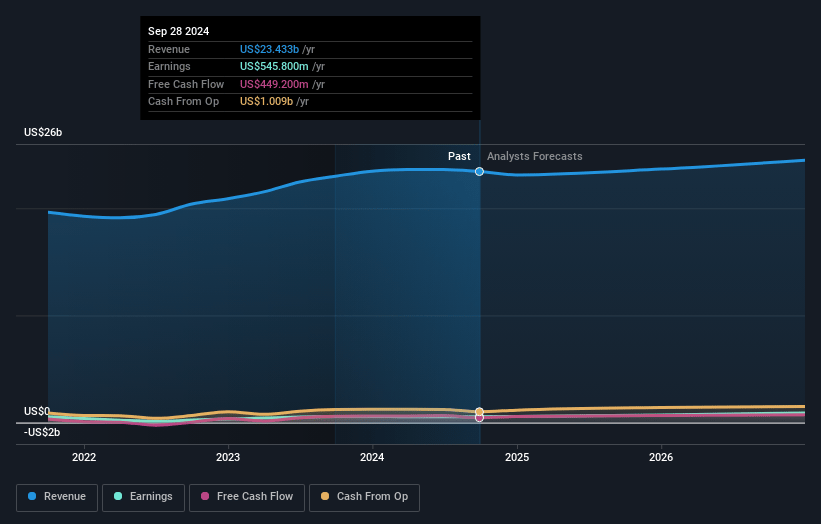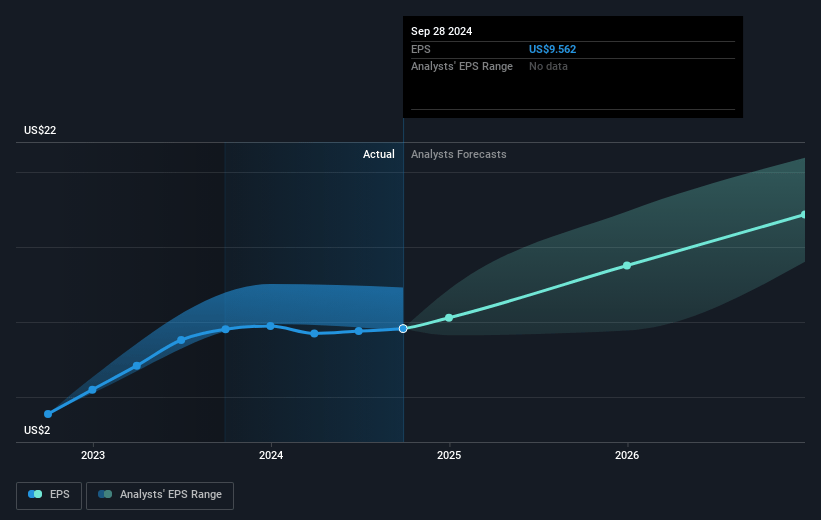Key Takeaways
- Successful new business awards in China and focus on high-value products like ComfortFlex could drive substantial revenue and margin growth for Lear.
- Strategic cost reduction and share repurchase programs are likely to enhance net margins and EPS, boosting shareholder value.
- Lear faces revenue and margin pressures from decreased vehicle production, macroeconomic challenges, reliance on Chinese automakers, and potential delays with major customers.
Catalysts
About Lear- Designs, develops, engineers, manufactures, assembles, and supplies automotive seating, and electrical distribution systems and related components for automotive original equipment manufacturers in North America, Europe, Africa, Asia, and South America.
- Lear's recent successful new business awards with significant automakers in China (e.g., BYD, Xiaomi, Dongfeng Group) could lead to substantial revenue growth as these programs are expected to generate over $100 million in average annual sales. This supports overall revenue expansion.
- The strategic focus on automation and cost reduction, including moving labor-intensive operations to lower-cost regions like Honduras, is likely to improve net margins by reducing manufacturing expenses and increasing efficiency.
- Lear's innovative ComfortFlex and ComfortMax seat products are seeing growing interest and adoption, with the company targeting $1 billion in revenue from Thermal Comfort by 2027, indicating potential revenue and margin growth due to high-value product offerings.
- Continued expansion and diversification of Lear's customer base in China, with revenue expected to grow by 6% annually to reach $6 billion by 2027, aligns with improved earnings potential as local market share increases significantly.
- The company's ongoing share repurchase program, having already reduced share count by over 4.5% in 2024, is expected to continue driving EPS growth, enhancing shareholder value through disciplined capital return strategies.
Lear Future Earnings and Revenue Growth
Assumptions
How have these above catalysts been quantified?- Analysts are assuming Lear's revenue will grow by 1.5% annually over the next 3 years.
- Analysts assume that profit margins will increase from 2.3% today to 3.8% in 3 years time.
- Analysts expect earnings to reach $927.2 million (and earnings per share of $17.18) by about January 2028, up from $545.8 million today.
- In order for the above numbers to justify the analysts price target, the company would need to trade at a PE ratio of 9.1x on those 2028 earnings, down from 9.6x today. This future PE is lower than the current PE for the US Auto Components industry at 18.3x.
- Analysts expect the number of shares outstanding to decline by 0.22% per year for the next 3 years.
- To value all of this in today's terms, we will use a discount rate of 8.18%, as per the Simply Wall St company report.
Lear Future Earnings Per Share Growth
Risks
What could happen that would invalidate this narrative?- The significant decrease in global vehicle production by 5% year-over-year and the negative impact of lower volumes on Lear platforms challenge revenue and margin growth prospects.
- The uncertain macroeconomic conditions, including vehicle affordability, regulatory changes, and wage inflation, are causing slower customer sourcing activity, which affects future order intakes and revenue growth.
- Lear's heavy reliance on Chinese domestic automakers for future growth could expose it to geopolitical risks and market volatility, potentially impacting revenue projections.
- The need to consistently optimize manufacturing costs and address labor inflation may pressure operating margins, thus affecting earnings.
- The potential for ongoing production delays and inventory corrections at major customers like GM could lead to lower-than-expected revenue and challenge Lear’s ability to meet financial projections.
Valuation
How have all the factors above been brought together to estimate a fair value?- The analysts have a consensus price target of $126.29 for Lear based on their expectations of its future earnings growth, profit margins and other risk factors. However, there is a degree of disagreement amongst analysts, with the most bullish reporting a price target of $174.0, and the most bearish reporting a price target of just $99.0.
- In order for you to agree with the analyst's consensus, you'd need to believe that by 2028, revenues will be $24.5 billion, earnings will come to $927.2 million, and it would be trading on a PE ratio of 9.1x, assuming you use a discount rate of 8.2%.
- Given the current share price of $96.08, the analyst's price target of $126.29 is 23.9% higher.
- We always encourage you to reach your own conclusions though. So sense check these analyst numbers against your own assumptions and expectations based on your understanding of the business and what you believe is probable.
How well do narratives help inform your perspective?
Disclaimer
Warren A.I. is a tool utilizing a Large Language Model (LLM) that ingests data on consensus price targets, forecasted revenue and earnings figures, as well as the transcripts of earnings calls to produce qualitative analysis. The narratives produced by Warren A.I. are general in nature and are based solely on analyst data and publicly-available material published by the respective companies. These scenarios are not indicative of the company's future performance and are exploratory in nature. Simply Wall St has no position in the company(s) mentioned. The price targets and estimates used are consensus data, and do not constitute a recommendation to buy or sell any stock, and they do not take account of your objectives, or your financial situation. Note that Warren A.I.'s analysis may not factor in the latest price-sensitive company announcements or qualitative material.
Read more narratives
There are no other narratives for this company.
View all narratives



